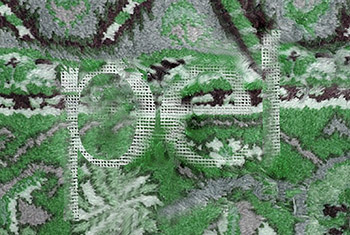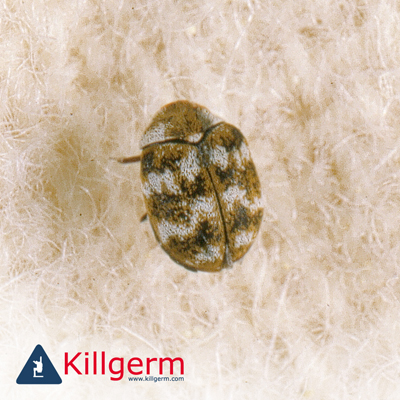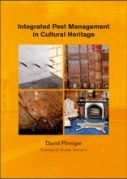How to ensure your collections are safe from insect pests.
All too often, pest control in museums is reactive, rather than proactive. Waiting for the discovery of evidence of insect pest activity, such as damage to objects or elements of the building can mean matters are already at an advanced stage and more difficult to resolve. 
When we talk about pests, often thoughts turn to the common species that are known to transfer disease and infection, such as rodents, cockroaches and flies. However, not all pest species are what we might term as 'public health' risks, and therefore the presence of some pests does not automatically mean there is an associated risk to people’s health. But, in the right environment, many pests can be incredibly destructive and will decimate their preferred food source.
In a museum or gallery, display or storage environment, the risk to exhibits or works of art from insect pests is a major priority.
Prevention of insect infestations is the first step
As always, prevention is better than cure, so be proactive with your pest control measures. If you think there may be bird species roosting and nesting on your building, it is essential that you take action. Birds’ nests are reservoirs of infestation for a number of insect pests, including those that will damage fabrics such as clothes moths and carpet beetles. 
Nests are often made up of animal derived products (feathers), making them perfect breeding sites for textile insect pests. If you have birds nesting on your property, they must be removed and the area treated, or you will always have the potential for infestation.
Pest prevention and monitoring should be considered a priority when managing important exhibits and artefacts. There are a variety of insect monitoring tools and lures that can act as an early warning system for your properties and collections. However, monitors are only beneficial if they are maintained and inspected on a regular basis, so it is essential that a plan is in place and that you can check them regularly to maintain a pest free environment. Traps and lures have been developed to target specific species utilising scents and visual stimulus, for example this clothes moth trap is specifically designed for detection of clothes moths.

To see all insect traps click here
Textile Pests
Clothes Moths and Carpet Beetles are the most common textile pests in the UK, and an infestation of either/ or both can decimate a collection. They have the ability to digest the fibrous protein 'Keratin' which forms the main structure of natural materials such as hair or feathers and is present in leather. This ability and appetite puts textiles and works made from wool, silk, fur, vellum and leather at risk. Damage caused by textile pests is performed by the larvae, making detection difficult due to their size, especially in the early stages of infestation. Early signs would be new holes in objects (bringing into focus the importance of ongoing monitoring), and 'Frass'. Frass is the excrement of the larvae, which might appear as a dust or powdery substance.
- Common Clothes Moths | Egg - Adult in around 7-12 weeks
- Case Bearing Clothes Moths | Egg - Adult in around 6-16 weeks
- Variegated Carpet Beetle | Egg - Adult anywhere from 9 months to 3 years
 The larval/pupation stage is significantly longer than the adult life of these three species.
The larval/pupation stage is significantly longer than the adult life of these three species.
Have you acquired an insect problem?
An essential part of any pest prevention policy in a museum or gallery is to keep pests out of collections. Insects can be introduced from many sources including new acquisitions, objects on loan from other collections and items returned from loan. A monitored quarantine area for incoming materials would be a good way to prevent a new pest being introduced. Objects must be checked for infestation before being allowed into the main collection areas, whether storage or display. 
Inspection may reveal insect damage, eggs or small larvae. Similarly, the emergence of holes from wood-boring insects may be apparent, however not so obvious if there are any developing larvae hidden in the item. Therefore in this case, an incubation period may be necessary to determine whether an infestation is active or long dead
Don’t forget – it can be difficult to identify when insect damage has occurred, so it is important that a condition report is made for all objects loaned to other organisations, and is checked thoroughly on their return.
Buildings – keeping pests out
Most modern buildings successfully prevent the entry of pests by careful design and detailing of potential entry points such as doors, windows and vents. Building standards and the improvements to heating and ventilation systems have also played a part in creating environments that are generally less attractive to insect pests. If you are planning a new building then it is worth discussing the special needs of your collection with the architect and including this in the initial design brief.
Excluding pests from older and historic buildings is often far more difficult, because of the unacceptable appearance of some proofing methods. You may need to take advice from a pest control consultant who has experience of dealing with such situations.
In the first instance action should be taken to:
- Isolate any objects suspected of being infested, to prevent spread of infestation to other objects.
- Clean infested areas and remove insect bodies, droppings and debris from the museum in a sealed container.
- Dispose of debris in such a way that it does not become a potential food source for new pests that might then re-infest the site.
- Decide on the most appropriate treatment.
In most cases it's impossible to have a completely pest-free environment
Unfortunately, even with the most comprehensive controls, you still may fall foul of pests. It is not usually practical to totally exclude all pests from a building, so it is important that they are denied a suitable environment in which to feed and breed when they do get in. Many insect pests can fly and may enter properties through open doors and windows. With moths and beetles it is the larvae that cause all the damage. The longer you have adult insects in your property, the more eggs they lay and the more activity there will be to control. So act quickly if you see any insects, and inform your pest controller.
4 Key points to avoid infestation
The key to avoiding pest infestations is to understand the conditions under which they thrive. By denying them the four things they need -
- food
- warmth
- humidity
- harbourage
It is possible to prevent them from becoming established if these four key factors are disrupted. The four factors are often inter-linked and achieving the right balance is not always straightforward, but it is also important you develop the right procedures. David Pinniger's book, Integrated Pest Management For Cultural Heritage covers prevention strategy in great detail.
So what's the cure?
The most effective pest control measures are preventive; regular monitoring and the avoidance and exclusion methods described above should be the priority. Only when these methods prove ineffective should professional treatments be considered. If pests are found in objects or in the building then a decision must be made on whether some remedial action is necessary and, if so, what it should be.
Treatments
Dealing with any pests and chemical related treatments is best left to professional pest controllers to prevent any legal ramifications, failed treatments or damage to collections. However you do need to ensure that the techniques and chemicals your contractor uses are safe for your staff, visitors and the collections. Ask your pest control contractor who will have experience of working in a museum environment. Your area museum council should also be able to advise. The choice of treatment method will depend upon the severity of the infestation, the type of material and the value of the object. The treatment of objects should only be carried out after taking the advice of a conservation or collections care specialist. In many situations, the application of an appropriate residual insecticide such as permethrin micro-emulsion will be sufficient to tackle an isolated outbreak of insect infestation. If your museum collection is made up of fragile and precious items, the pest control industry can offer you a number of innovative solutions to solve your textile pest issues.
Some standard insecticide formulations may not be suitable for treating specialist items. However heat, cold, carbon dioxide and even hormone confusion can all be used as controlling agents for textile pests, so ensure your contractor is considering such processes to preserve the integrity of your collections. These developments in the pest control industry mean that museums now have a number of options for treatments that will prevent or eradicate pests, if carried out correctly.